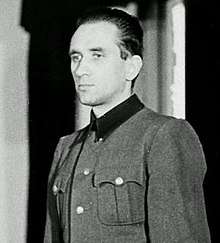Friedrich Entress
Friedrich Karl Hermann Entress (8 December 1914 – 28 May 1947) was a German camp doctor in various concentration and extermination camps during the Second World War. He conducted human medical experimentation at Auschwitz and introduced the procedure there of injecting lethal doses of phenol directly into the hearts of prisoners. He was captured by the Allies in 1945, sentenced to death at the Mauthausen-Gusen camp trials, and executed in 1947.
Dr Friedrich Entress | |
|---|---|
 | |
| Born | 8 December 1914 |
| Died | 28 May 1947 (aged 32) |
| Allegiance | |
| Service/ | Schutzstaffel (SS) |
| Years of service | 1939–1945 |
| Rank | Hauptsturmführer |
Early life
Friedrich Entress was born on 8 December 1914 in Posen, a Polish-Prussian province,[1] and graduated in medicine in either 1938[2] or 1939.[1] He was able to receive his doctorate in 1942 without writing a dissertation, "a privilege granted to Germans from the east".[3] He had grey eyes and dark blonde hair and was described as having a "Nordic" profile. According to Michael Kater, he was part of a vigilante group of ethnic Germans that was supported by the Schutzstaffel (SS), and after the German invasion of Poland he joined the SS-Totenkopfverbände.[1]
Second World War
Entress departed to various concentration camps as an SS doctor,[1] starting with a post at Gross-Rosen concentration camp in 1941.[3] He was at the main Auschwitz camp between 11 December 1941 and 21 October 1943. During the last seven or eight months (March 1943 to 20 October 1943) at Auschwitz, he became camp physician at Buna-Monowitz workcamp,[4] also part of the Auschwitz camp system. Subsequently, Entress in October 1943 became senior physician at Mauthausen-Gusen. By 1945, he was an SS surgeon.[1][5]
On the death toll among inmates at Monowitz, where IG Farben had manufacturing facilities, Entress later commented, "The turnover of inmates in Monowitz was enormous. The inmates were weak and malnourished. It should be emphasised that the performance demanded of the inmates was not in accord with their living conditions and nutrition".[5]
He conducted human medical experimentation at Auschwitz, along with Helmut Vetter and Eduard Wirths,[6] where he operated in "Block 21" and was paid by the Bayer pharmaceutical subsidiary of IG Farben to test experimental drugs against typhus and tuberculosis (TB).[4]
Experiments included collapsing the lungs of people with TB. Establishing a TB ward, he perfected the technique before killing all those on the ward by injecting lethal doses of phenol directly through the chest wall and into the victims hearts,[7] allowing up to 100 people to be killed each day.[3] He became a key player in the organisation and administration of killings by phenol.[4][8] The practice may have been used to cover up the results of experimental medical procedures, including surgery, that he and other physicians at the camp carried out despite not having surgical qualifications.[6][9] In 1942, he gave Bayer associate Helmut Vetter approval to test TB drug Rutenol, an arsenic acid derivative.[7]
Josef Mengele, who had arrived at Auschwitz in May 1943, five months before Entress left for Mauthausen-Gusen,[4] carried on TB work at Auschwitz from 1943.[7]
At one time, Czech physician Karel Sperber worked under Entress.[10]
Capture and death
Entress was captured by the Allies in May 1945, when he was serving as a surgeon with an SS tank division. At the Mauthausen-Gusen camp trials in 1946 he was sentenced to be executed by hanging.[1] He did not testify in his own defence but petitions for clemency were received after the verdict from his wife Else and from Entress himself. The petitions were rejected and he was hanged on 28 May 1947 at Landsberg Prison.[11][12]
References
- Kater, Michael H. (1989). Doctors Under Hitler. USA: University of North Carolina Press. p. 73. ISBN 0-8078-1842-9.
- Weindling, Paul (2015). Victims and Survivors of Nazi Human Experiments: Science and Suffering in the Holocaust. Bloomsbury Academic. p. 200. ISBN 978-1-4411-7990-6.
- Francis R. Nicosia; Jonathan Huener (2002). Medicine and Medical Ethics in Nazi Germany: Origins, Practices, Legacies. Berghahn Books. p. 68. ISBN 978-1-57181-387-9.
- Bacon, Ewa K. (2017). Saving Lives in Auschwitz: The Prisoners Hospital in Buna-Monowitz. Purdue University Press. p. 38. ISBN 9781557537799.
- Tully, John (2011). The Devil’s Milk: A Social History of Rubber. Monthly Reviews Press. p. 304. ISBN 978-1-58367-231-0.
- www.auschwitz.org. "Other doctor-perpetrators / Medical experiments / History / Auschwitz-Birkenau". auschwitz.org. Retrieved 12 October 2018.
- Murray, J.F.; Loddenkemper, R. (2018). Tuberculosis and War: Lessons Learned from World War II. Karger. p. 54. ISBN 978-3-318-06095-9.
- Barr, Robert (2017). Where Is the World Going?. Dorrance Publishing. p. 56. ISBN 978-1-4809-3796-3.
- Gutman, Israel; Berenbaum, Michael (1994). Anatomy of the Auschwitz Death Camp. Indiana University Press. p. 262. ISBN 0-253-20884-X.
- Weindling, Paul (2017). From Clinic to Concentration Camp: Reassessing Nazi Medical and Racial Research, 1933-1945. Routledge. ISBN 9781317132394.
- United States vs. Hans Altfuldisch et al Case No. 000-50-5. Commander in Chief European Command, 1947. p. 28. via jewishvirtuallibrary.org Retrieved 19 October 2018.
- Dȩbski, Jerzy. (1995) Death Books from Auschwitz: Remnants - Volume 1. K.G. Saur. p. 251. ISBN 9783598112621